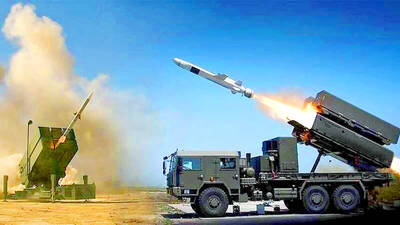China has carried out a land-based missile interception test that “achieved its expected purpose,” the Chinese Ministry of National Defense said, adding that it was for defensive purposes and not aimed at any country.
China has been ramping up research into many types of missiles, from those that could destroy satellites in orbit to advanced nuclear-tipped ballistic missiles, as part of an ambitious modernization scheme overseen by Chinese President Xi Jinping (習近平).
Beijing has tested missile interceptors before. The most recent public announcement of a test was in February last year, and before that in 2018.
State media said that China has conducted anti-missile system tests since at least 2010.
The ministry in a brief statement on Sunday said that the “ground-based midcourse anti-missile intercept technology” test had been carried out that night.
“The test reached its expected goals,” the ministry said. “This test was defensive and not aimed at any country.”
It provided no other details.
China, along with its ally Russia, has repeatedly expressed opposition to US deployment of the Terminal High Altitude Area Defense anti-missile system in South Korea, saying that the equipment’s powerful radar could penetrate into its territory.
China and Russia have also held simulated anti-missile drills.
China has given few details about its own missile programs, aside from occasional brief statements by the defense ministry or in state media.
In 2016, the ministry confirmed it was pressing ahead with anti-missile system tests after pictures of the operations appeared on state television.
Beijing said that such technology is needed for national defense and security.

AIR DEFENSE: The Norwegian missile system has proved highly effective in Ukraine in its war against Russia, and the US has recommended it for Taiwan, an expert said The Norwegian Advanced Surface-to-Air Missile Systems (NASAMS) Taiwan ordered from the US would be installed in strategically important positions in Taipei and New Taipei City to guard the region, the Ministry of National Defense said in statement yesterday. The air defense system would be deployed in Taipei’s Songshan District (松山) and New Taipei City’s Tamsui District (淡水), the ministry said, adding that the systems could be delivered as soon as the end of this year. The US Defense Security Cooperation Agency has previously said that three NASAMS would be sold to Taiwan. The weapons are part of the 17th US arms sale to

SERIOUS ALLEGATIONS: The suspects formed spy networks and paramilitary groups to kill government officials during a possible Chinese invasion, prosecutors said Prosecutors have indicted seven retired military officers, members of the Rehabilitation Alliance Party, for allegedly obtaining funds from China, and forming paramilitary groups and assassination squads in Taiwan to collaborate with Chinese troops in a possible war. The suspects contravened the National Security Act (國家安全法) by taking photos and drawing maps of key radar stations, missile installations and the American Institute in Taiwan’s headquarters in Taipei, prosecutors said. They allegedly prepared to collaborate with China during a possible invasion of Taiwan, prosecutors said. Retired military officer Chu Hung-i (屈宏義), 62, a Republic of China Army Academy graduate, went to China

INSURRECTION: The NSB said it found evidence the CCP was seeking snipers in Taiwan to target members of the military and foreign organizations in the event of an invasion The number of Chinese spies prosecuted in Taiwan has grown threefold over a four-year period, the National Security Bureau (NSB) said in a report released yesterday. In 2021 and 2022, 16 and 10 spies were prosecuted respectively, but that number grew to 64 last year, it said, adding that the Chinese Communist Party (CCP) was working with gangs in Taiwan to develop a network of armed spies. Spies in Taiwan have on behalf of the CCP used a variety of channels and methods to infiltrate all sectors of the country, and recruited Taiwanese to cooperate in developing organizations and obtaining sensitive information

BREAKTHROUGH: The US is making chips on par in yield and quality with Taiwan, despite people saying that it could not happen, the official said Taiwan Semiconductor Manufacturing Co (TSMC, 台積電) has begun producing advanced 4-nanometer (nm) chips for US customers in Arizona, US Secretary of Commerce Gina Raimondo said, a milestone in the semiconductor efforts of the administration of US President Joe Biden. In November last year, the commerce department finalized a US$6.6 billion grant to TSMC’s US unit for semiconductor production in Phoenix, Arizona. “For the first time ever in our country’s history, we are making leading edge 4-nanometer chips on American soil, American workers — on par in yield and quality with Taiwan,” Raimondo said, adding that production had begun in recent